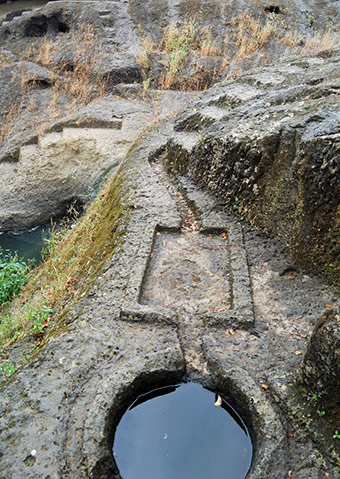New Buddhist Caves Found in Sanjay Gandhi National Park in Mumbai

Buddha in Cave 3 of Kanheri Caves: There are over a 100 Buddhist caves in the northern part of Sanjay Gandhi National Park in Mumbai.
Seven ancient caves have been discovered in the northern fringes of Sanjay Gandhi National Park in Mumbai. These caves are Buddhist ‘viharas’ where monks used to live and meditate. These caves are believed to have been built between 1st century BC and 5th and 6th century AD. That means they are older than the Kanheri Caves. The new caves are about an hour’s hike from the Kanheri Caves. They probably served as monsoon shelters for the monks.

Rainwater harvesting system of Kanheri Caves: Buddhist caves are usually found near water bodies. They also have water harvesting systems.
These caves are simpler in form; also they lack the water cisterns found in the Kanheri Caves. In addition, some monolithic tools which were used in the 1st century BC have been found in these caves. Archeologists believe that these caves were used by the monks during monsoon because they lack water cisterns.
Kanheri Caves have more evolved architecture. They are famous for their water harvesting and rain water management systems.

Hall of Cave 3 of Kanheri Caves in Sanjay Gandhi National Park, Mumbai
Monks usually build their caves near a water body. In order to reach the new caves, you have to hike to a water fall beyond the Kanheri Caves. A 20 minutes’ hike will take you to the base of the waterfall. From there you have to hike through dense cactus and other plants to reach the top of the waterfall. The caves are on either side of the waterfall. They are made from natural rock. They have smooth curves, plastering and benches to sleep on. All of these features clearly indicate that they are man-made caves. One of the caves was inhabited till recently. It even has modern bathroom tiles. Sadhus (monks) used to live in the Sanjay Gandhi National Park until the Bombay High Court ordered their eviction from the park in the late 1990’s. This cave must have been used by one of them.
Mumbai has several archeological sites. The Kanheri Buddhist Caves in the Sanjay Gandhi National Park have been known for quite some time. These Caves have been documented by both British and Portuguese travelers. There are over a 100 caves. They were built between the 1st century BC and 14th century AD. The monks had them built by sculptors and artisans. Initially these caves served as places of worship and monasteries. Over the centuries they evolved into educational institutes. The Kanheri Caves have several inscriptions and sculptures. Early inscriptions are in the Brahmi script. Later inscriptions are in the Nagari script. Most inscriptions are in Prakrit and Sanskrit languages. There are also some inscriptions in the Japanese language.
